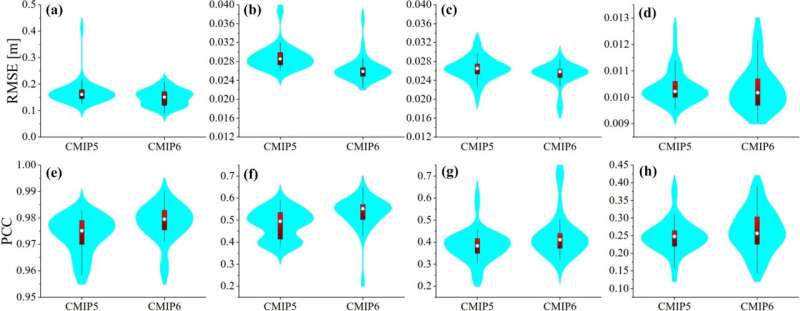This article has been reviewed according to Science X's editorial process and policies. Editors have highlighted the following attributes while ensuring the content's credibility:
fact-checked
trusted source
proofread
Scientists sort out uncertainties in sea level projections

As global temperatures continue to rise, coastal communities are confronted with the pressing challenge of surging sea levels. The urgency to provide decision-makers with reliable forecasts of future sea levels becomes increasingly critical. At the forefront of this predictive effort lies Dynamic Sea Level (DSL), a nuanced variable intricately linked to seawater density and ocean circulation, currently under intensive scrutiny in climate models.
The Ocean Modeling Team at the Institute of Atmospheric Physics, Chinese Academy of Sciences, recently conducted an extensive study, unraveling the uncertainties surrounding DSL projections using the cutting-edge Coupled Model Intercomparison Project Phase 6 (CMIP6) ensemble and the expansive FGOALS-g3 super-large ensemble.
Their study reveals that concerning basin-scale dynamics, intermodel uncertainty plays a leading role, contributing over 55%, 80%, and 70% to the total uncertainty of DSL projections in the near term (2021-2040), midterm (2041-2060), and long term (2081-2100), respectively. Following closely is internal variability, accounting for 10-42% in the near term and less than 20% in the midterm. While the impact of scenario uncertainty is initially minimal, it gradually ascends, surpassing contributions from internal variability in the long term.
Professor Hailong Liu, the corresponding author of the series of recently published studies, emphasized, "There are also regional nuances. At the regional scale, internal variability dominates in the near term for the Pacific Ocean, Indian Ocean, and the western boundary of the Atlantic Ocean. Conversely, intermodel uncertainty takes the spotlight in other regions. Contributions evolve over time, with scenario uncertainty becoming significant in the Southern, Pacific, and Atlantic Oceans in the long term."
The research team also observed that anthropogenic DSL signals are expected to emerge from specific regions by the close of this century. The refinement of the CMIP6 ensemble, achieved by eliminating model differences, enhances our ability to detect these signals in advance.
"Imagine trying to understand Earth's climate using a computer model. Instead of running the model just once, we run it many times with slight variations in the starting conditions. This helps us see how the model responds to different situations," explained Prof. Liu.
"By doing this, we can better measure how the Earth's climate reacts to external factors, like changes in greenhouse gases, and also understand the natural ups and downs that happen on their own. This way, we get a clearer and more reliable picture of how our climate works."
The team, therefore, gains insights from the FGOALS-g3 Super-Large Ensemble, featuring 110 model members, aligning seamlessly with CMIP6 members in basin-mean DSL projections. A comparative analysis with the CMIP6 ensemble reveals larger estimates of internal variability in the FGOALS-g3 super-large ensemble.
So, what are the implications for tomorrow? The team's research not only deepens our comprehension of rising sea levels but also lays the groundwork for more accurate and informed climate models. The insights gleaned are instrumental in securing the future of our coastal communities.
These findings have recently been published in the Journal of Climate, Advances in Atmospheric Sciences, and Geoscience Letters.
More information: Chenyang Jin et al, Uncertainties in the Projection of Dynamic Sea Level in CMIP6 and FGOALS-g3 Large Ensemble, Journal of Climate (2024). DOI: 10.1175/JCLI-D-23-0272.1
Chenyang Jin et al, Evaluation of the seasonal to decadal variability in dynamic sea level simulations from CMIP5 to CMIP6, Geoscience Letters (2023). DOI: 10.1186/s40562-023-00291-w
Provided by Chinese Academy of Sciences




















